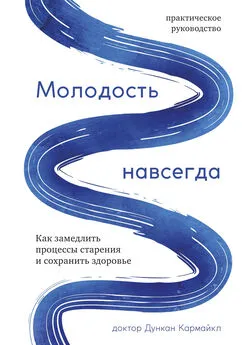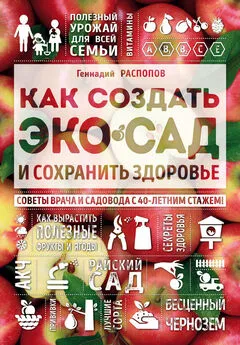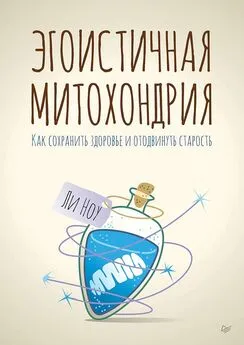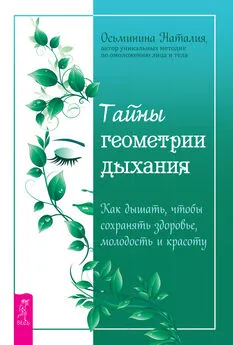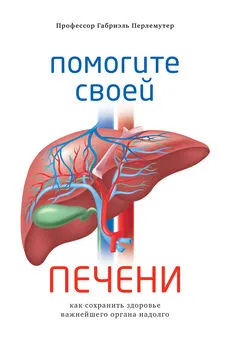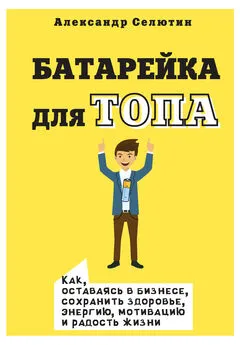Дункан Кармайкл - Молодость навсегда. Как замедлить процессы старения и сохранить здоровье
- Название:Молодость навсегда. Как замедлить процессы старения и сохранить здоровье
- Автор:
- Жанр:
- Издательство:неизвестно
- Год:2018
- ISBN:978-5-389-18963-8
- Рейтинг:
- Избранное:Добавить в избранное
-
Отзывы:
-
Ваша оценка:
Дункан Кармайкл - Молодость навсегда. Как замедлить процессы старения и сохранить здоровье краткое содержание
«Современный мир дает возможность как поддерживать здоровье в пре-красном состоянии, так и еще в молодом возрасте „заработать“ тяжелые хронические заболевания. Очевидно, что в большинстве случаев наше здоровье в наших руках. Вопрос в том, как определить, что помогает, а что вредит? Все так быстро меняется во всех областях медицины, что вчерашнее лекарство завтра может быть признано вредным (и это не учитывая аферистов в белых халатах, пытающихся впарить шарлатанские средства от всех болезней). Поиск надежной информации в эпоху интернета становится нелегкой задачей. Моя цель – составить для вас полезную дорожную карту». (Дункан Кармайкл)
В формате PDF A4 сохранён издательский дизайн.
Молодость навсегда. Как замедлить процессы старения и сохранить здоровье - читать онлайн бесплатно ознакомительный отрывок
Интервал:
Закладка:
52
Andziak, B. et al. ‘Antioxidants do not explain the disparate longevity between mice and the longest living rodent, the naked mole-rat’. Mech Ageing Dev(2005): 126: 1206–1212.
53
Guallar, E. et al. ‘An editorial update: Annus horribilis for vitamin E.’ Ann Intern Med (2005): 143: 143–145.
54
Melov, S. et al. ‘Extension of life-span with superoxide dismutase/catalase mimetics.’ Science (2000): 289: 1567–1569.
55
Bayne, A. C. et al. ‘Effects of superoxide dismutase/catalase on lifespan and oxidative stress resistance in the housefly, Musca domestica.’ Free Radic Biol Med (2002): 32: 1229–1234.
56
Rose, M. R. The Long Tomorrow: How Advances in Evolutionary Biology Can Help Us Postpone Aging. Oxford University Press, USA (2005).
57
Kenyon, C. et al. ‘A C elegans mutant that lives twice as long as wild type.’ Nature 366: 1993: 404–405.
58
Martins, R. et al. ‘Long live FOXO: unravelling the role of FOXO proteins in aging and longevity.’ Aging Cell (2016): 15: 196–207.
59
Sinclair, D. A. et al. ‘Small molecule activators of sirtuins extend Saccharomyces cere-visiae lifespan.’ Nature (2003): 425: 191–196.
60
Sinclair, D. et al. ‘Sirtuin activators mimic caloric restriction and delay ageing in meta-zoans.’ Nature (2004): 430: 686–689.
61
Khushwant, S. ‘Lifespan and healthspan extension by resveratrol.’ BBA Mol Basis Dis (2015): 1852: 1209–1218.
62
Semba, R. D. et al. ‘Resveratrol levels and all-cause mortality in older community-dwelling adults.’ JAMA (2014): 174: 1077–1084.
63
Nedergaard, M. et al. ‘Beneficial effects of low alcohol exposure, but adverse effects of high alcohol intake on glymphatic function.’ Nature Res (2018): 8: 2246. URL: https://www.nature.com/articles/s41598–018–20424y.
64
Park, D. et al. ‘Resveratrol induces autophagy by directly inhibiting mTOR through ATP competition.’ Nature (2016): 6: 21772. URL: https://www.nature.com/articles/srep21772.
65
‘Cynthia Kenyon: “The idea that ageing was subject to control was completely unex-pected.” ’ The Guardian (2013).
66
Ehninger, D. et al. ‘Longevity, aging and rapamycin.’ Cell Mol Life Sci (2014): 71: 4325–4346.
67
Hammel, H. T. et al. ‘Thermal and metabolic responses of the Kalahari bushmen to moderate cold at night.’ Researchgate (1963). URL: https://www.researchgate.net/publication/235016637_Thermal_and_metabolic_responses_of_the_Kalahari_bushmen_to_moderate_cold_exposure_at_night.
68
Keil, G. et al. ‘Being cool. How body temperature influences ageing and longevity.’ Biogerontology (2015): 16: 383–397.
69
Simonsick, E. M. et al. ‘Basal body temperature as a biomarker of healthy aging.’ Age (2016): 38: 445–454.
70
Mooventhan, A. et al. ‘Scientific evidence-based effects of hydrotherapy on various systems of the body.’ N Am Med J Sci (2014): 6: 199–209.
71
Peake, J. M. et al. ‘The effects of cold water emersion and active recovery on inflammation and cell stress responses in human skeletal muscle after resistance exercise’. J Physiol (2017): 595: 695–711.
72
Semenza, J. C. et al. ‘Heat-related deaths during the July 1995 heat wave in Chicago.’ N Engl J Med (1996): 335: 84–90.
73
McCay, C. M. et al. ‘The effect of retarded growth upon the length of life span and upon the ultimate body size’ (1935). Nutrition (1989): 5: 155–171.
74
Lee, C. et al. ‘Dietary restriction with and without calorie restriction for healthy aging.’ MC (2016): 5. URL: https://www.ncbi.nlm.nih.gov/pmc/articles/PMC 4755412/.
75
Speakman, J. R. et al. ‘Starving for life: What animal studies can and cannot tell us about the use of Caloric Restriction to prolong human Lifespan.’ J Nutr 137: (2007): 1078–1086.
76
Gredilla, R. et al. ‘Caloric restriction decreases mitochondrial free radical generation at complex 1 and lowers oxidative damage to mitochondrial DNA in the rat heart.’ FASEB Journal (2001). URL: http://www.fasebj.org/doi/10.1096/fj.00–0764fje.
77
Lin, S. J. et al. ‘Calorie restriction extends Saccharomyces by cerevisiae lifespan by increasing respiration.’ Nature (2002): 418: 344–348.
78
Greer, E. L. et al. ‘Dif erent dietary restriction regimens extend lifespan by both independent and overlapping genetic pathways in C. elegans.’ Aging Cell (2009): 8: 113–127.
79
Soare, A. et al. ‘Long-term calorie restriction, but not endurance exercise lowers core body temperature in humans.’ Aging (2011): 374–379.
80
Larson-Meyer, D. E. et al. ‘Effect of calorie restriction with or without exercise on insulin sensitivity, B-cell function, fat cell size and ectopic lipid in overweight subjects.’ Diabetes Care (2006): 29: 1337–1344.
81
Longo, V. D. et al. ‘Evolutionary medicine: from dwarf model systems to healthy centenarians?’ Science (2003): 299: 1343–1346.
82
Guarente, L. and Kenyon, C. ‘Genetic pathways that regulate ageing in model organisms.’ Nature (2000): 408: 255–262.
83
Roberts, M. N. et al. ‘A ketogenic diet extends longevity and healthspan in adult mice.’ Cell Metabolism (2017): 26: 539–546.
84
Johnston, B. C. et al. ‘Comparison of Weight Loss Among Named Diet Programs in Overweight and Obese Adults: A Meta-analysis.’ JAMA (2014): 312: 923–933.
85
Chan, Y. C. et al. ‘Calorie restriction in the Okinawa people of Japan.’ J Cell Nutr (1997).
86
Anson, R. M. et al. ‘Intermittent fasting dissociates beneficial effects of dietary restriction on glucose metabolism and neuronal resistance to injury from calorie intake.’ Proc Natl Acad Sci USA (2003): 100: 6216–6220.
87
Периодическое голодание не рекомендуется людям, у которых диагностирован билиарный сладж или камни в желчном пузыре. Категорически нельзя голодать людям с инсулинозависимым диабетом и пациентам с инсулиннезависимым диабетом, принимающим лекарства для снижения сахара крови. – Прим. науч. ред .
88
Martin, B. et al. ‘Caloric restriction and intermittent fasting: two potential diets for successful brain aging.’ Ageing Res Rev (2006): 5: 332–353.
89
Keshel, T. E. et al. ‘Exercise training and insulin resistance: a current review.’ J Obes Weight Loss Ther (2015): 5: S 5–003.
90
Kohman, R. A. et al. ‘Voluntary wheel-running reverses age-induced changes in hippocampal gene expression.’ PLOS One (2011): 6: e22654.
91
Davis, R. A. H. et al. ‘High-intensity interval training and calorie restriction promote remodeling of glucose and lipid metabolism in diet-induced obesity.’ Am J Physiol Endocrinol Metab (2017): 313: E 243–56.
92
Zamir, D. et al, open letter. ‘The tomato genome sequence provides insights into fl eshy fruit evolution.’ Nature (2012): 485: 635–641.
93
Kupferschmidt, K. ‘How tomatoes lost their taste.’ ScienceNOW (28 June 2012). URL: http://news.sciencemag.org/sciencenow/2012/06/how-tomatoes-lost-their-taste.html.
94
Ford, E. et al. ‘Healthy living is the best revenge. Findings from the European prospect-ive investigation into cancer and nutrition – the Potsdam study.’ Arch Intern Med (2009): 169: 1355–1362.
95
Ibid.
96
Goodman, S. ‘Commonalities amongst centenarians.’ The Centenarian (2015).
97
‘Jeanne Calment, World’s Elder, Dies at 122.’ The New York Times (5 August 1997).
98
Lumeng, C. et al. ‘Inflammatory Links Between Obesity and Metabolic Disease.’ J Clin Invest (2011): 121: 2111–2117.
99
Santos-Lozano, A. et al. ‘Implications of Obesity in Exceptional Longevity.’ Ann Transl Med (2016): 4: 416.
100
Centers for Disease Control and Prevention. ‘Top 1 °Causes of Death in the United States from 1900–2010.’
101
‘Comprehensive Health Study in India Finds Rise of Non-communicable Diseases.’ IHME (2017). URL: http://www.healthdata.org/news-release/comprehensive-health-study-india-finds-rise-non-communicable-diseases.
102
Heron, M. ‘Deaths: Leading Causes for 2015.’ National Vital Statistics Reports (2017): 66 (5).
103
Bauer, U. E. et al. ‘Prevention of Chronic Disease in the 21st Century: Elimination of the Leading Preventable Causes of Premature Death and Disability in the USA.’ The Lancet (2014): 384: 45–52.
104
Mainous, G. et al. ‘Prevalence of Prediabetes in England from 2003 to 2011: Population-based, Cross-sectional Study.’ BMJ Open (2014): Vol. 4: Issue 6.
105
Endemann, D. H. et al. ‘Nitric Oxide, Oxidative Excess and Vascular Complications in Diabetes Mellitus.’ Curr Hypertens Rep (2004): Vol 6: 2: 85–89.
106
Liu, J. et al. ‘A Genetically Defined Model for Human Ovarian Cancer.’ Cancer Res (2004): 64: 1655–1663.
107
Heppner, F. L. et al. ‘Immune Attack: The Role of Inflammation in Alzheimer’s Disease.’ Nat Rev Neurosci (2015): 16: 358–372.
108
De Busk, L. M. ‘Tie2 Receptor Tyrosine Kinase, a Major Mediator of TNFa Induced Angiogenesis in Rheumatoid Arthritis.’ Arthritis Rheum (2003): 48: 9: 2461–2471.
109
Olen, O. et al. ‘Childhood Onset of Inflammatory Bowel Disease and Risk of Cancer: A Swedish Nationwide Cohort Study 1964–2014.’ BMJ (2017): doi: 10:1136/bmj.j3951.
110
Vine, A. K. et al. ‘Biomarkers of Cardiovascular Disease as Risk Factors for Age-related Macular Degeneration.’ Opthalmology (2005): 112: 2076–2080.
111
Fuster, V. and Kelly, B. B. ‘Promoting Cardiovascular Health in the Developing World: A Critical Challenge to Achieve Global Health.’ URL: https://www.ncbi.nlm.nih.gov/pubmed/20945571.
112
Anitschkow, N. N. and Chatalov, S. ‘Über experimentelle Cholesterinsteatose und ihre Bedeutung für die Entstehung einiger pathologischer Prozesse.’ Zentralbl Allg Pathol (1913): 24: 1–9.
Читать дальшеИнтервал:
Закладка:
